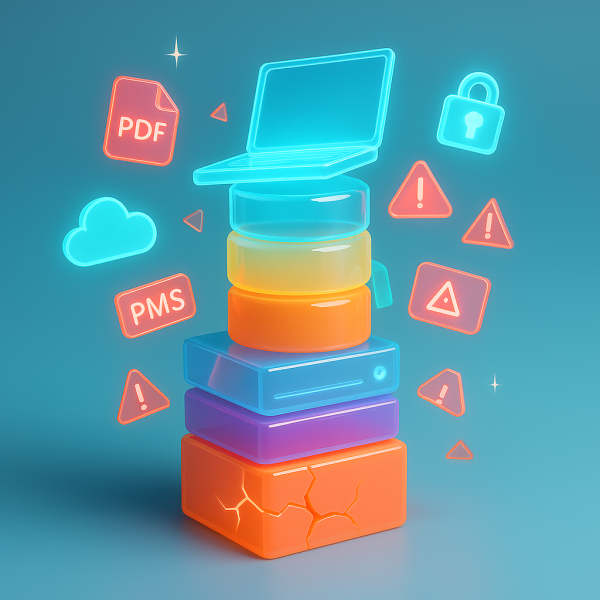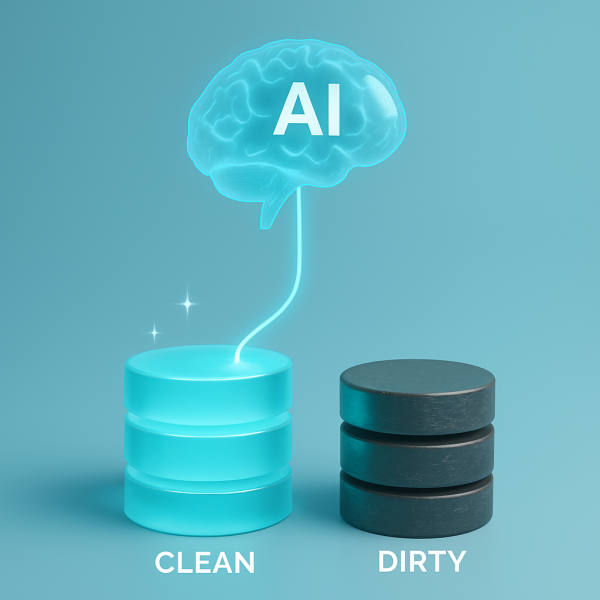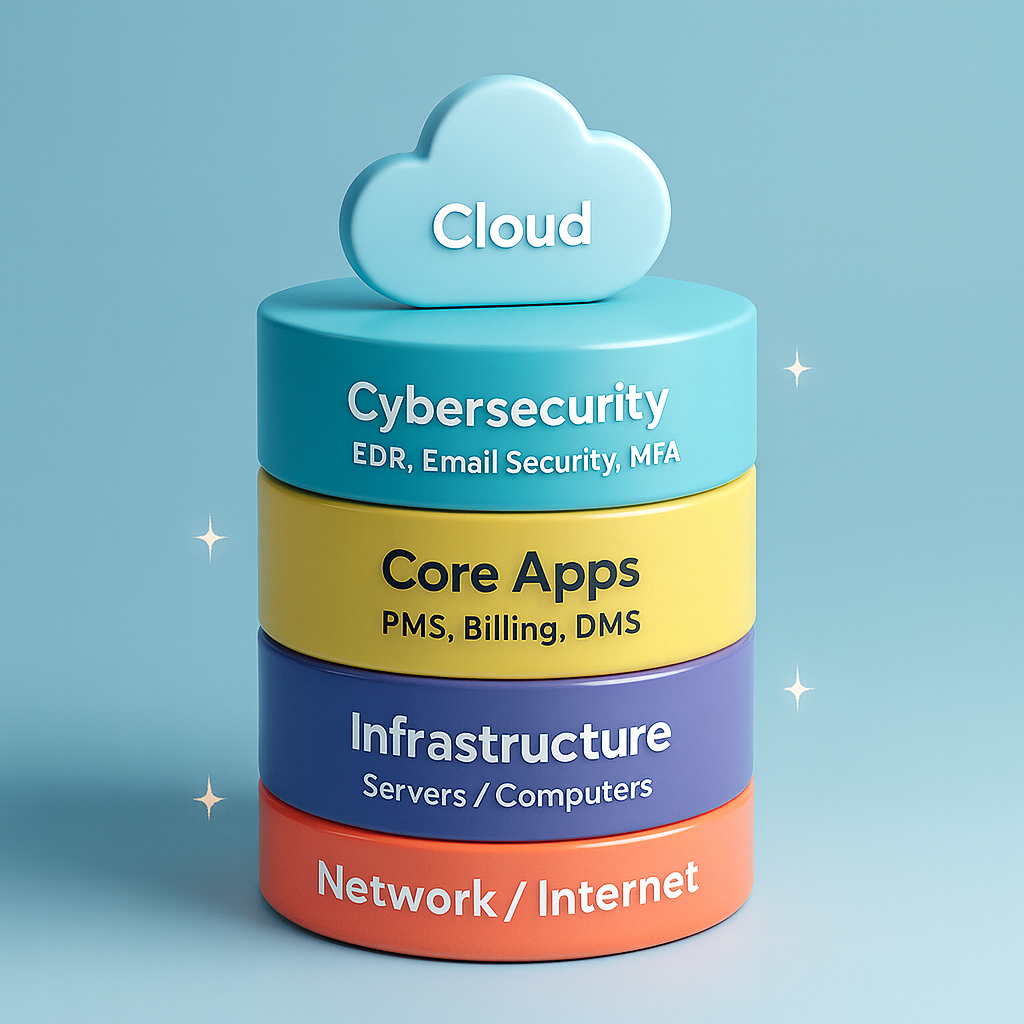The Hidden Chaos Behind the Scenes
 If you walk into almost any law firm, you’ll find a surprising amount of complexity. Over the years, new tools get added like layers of wallpaper:
If you walk into almost any law firm, you’ll find a surprising amount of complexity. Over the years, new tools get added like layers of wallpaper:
- A case management system that only half the lawyers use
- A billing system installed years ago because “it worked at the time”
- A server in a back room that everyone hopes never fails
- A patchwork of email security tools, document repositories, and backup drives
- PDF tools, scanning tools, AI plug-ins, cloud add-ons, browser extensions
- And, inevitably, a growing number of overlapping subscriptions
Each one addresses a specific need… but together, they create noise.
Lawyers switch between screens. Passwords multiply. Documents get lost. Training becomes a nightmare. And IT teams, or consultants like me, get called in to untangle the spaghetti.
Most importantly, this fragmentation is now a serious security risk.
Why Cybersecurity Is the Real Reason Consolidation Matters
 Law firms today are under more pressure than ever. Cyber-insurance requirements are rising. Regulators want better compliance. Corporate clients ask more detailed security questions. And hackers? They know law firms are gold mines of sensitive data.
Law firms today are under more pressure than ever. Cyber-insurance requirements are rising. Regulators want better compliance. Corporate clients ask more detailed security questions. And hackers? They know law firms are gold mines of sensitive data.
Every new tool in the stack adds:
- A new login
- A new vulnerability
- A new place where data can leak
- A new system someone forgets to update
- A new blind spot for a cyber attacker
The truth is simple:
Too many systems make your firm unsafe.
And with ransomware specifically targeting legal practices, the stakes have never been higher.
A consolidated tech stack — one where security, devices, documents, backups, and workflows operate inside a controlled environment, isn’t just convenient. It’s essential.
The AI Problem Nobody Talks About
 Everyone wants AI. That’s understandable, the efficiency gains are real.
Everyone wants AI. That’s understandable, the efficiency gains are real.
But here’s the part many people miss:
AI can’t do its job when your systems are scattered.
It needs:
- Clean data
- Centralized documents
- Consistent file structures
- Reliable permissions
- Standardized user access
- Secure cloud storage
- Integrated workflows
AI isn’t magic. It’s a machine that needs high-quality input.
A fragmented system means documents are stored in six different places, naming conventions vary wildly, users upload unstructured PDFs, and old servers hide years of forgotten data.
This isn’t an environment where AI shines, but it’s one where AI becomes unreliable or even dangerous.
Before a firm can use AI effectively, it must first be technologically organized.
What Modern Law Firms Are Doing Instead
In the last two years, I’ve seen a quiet shift. Law firms, especially small and mid-sized ones, are realizing that they don’t need more tools. They need the right tools.
They are:
- Retiring or replacing old servers
- Migrating to cloud practice-management platforms like Clio, Actionstep, MyCase, Centerbase
- Standardizing document storage
- Centralizing email security and backup
- Applying uniform endpoint protection, EDR, XDR, MDR across all devices
- Simplifying workflows instead of adding more
- Replacing 5–7 tools with one integrated platform
The result?
Lawyers work faster. Administrators train easier. Billing and documents sync. Cyber-insurance risks go down. And suddenly, AI becomes not only possible — but actually reliable.
The Real Transformation: From Patchwork to Platform
Let me give you a simple before-and-after story.
Before
A firm uses:
- A 10-year-old on-prem server
- Three separate billing tools
- A case system nobody fully adopted
- An unpredictable backup routine
- Three different email security tools over the years
- A dozen browser extensions to make up for gaps
- Manual intake forms
- And ad-hoc AI tools that employees downloaded themselves
This is extremely common.
After
That same firm consolidates around:
- A single cloud practice-management platform
- Integrated billing
- Encrypted cloud backup with retention
- Advanced email security, applied uniformly
- Centralized EDR, XDR, MDR protection
- Automated patch management
- A secure document repository
- Controlled, firm-approved AI tools
Suddenly, the environment is predictable, secure, efficient — and future-proof.
A Clean Stack Isn’t Just About Tech. It’s About Culture.
 When law firms consolidate and simplify their tech, something interesting happens:
When law firms consolidate and simplify their tech, something interesting happens:
- Staff feel less overwhelmed
- Training becomes faster
- Support tickets drop
- Resistance to change decreases
- New ideas get adopted more easily
- AI becomes less scary and more practical
- Lawyers stop fighting the software and start using it
It becomes a culture shift.
Technology goes from being a burden to being an advantage.
So What Should Law Firms Do Next?
Here’s the roadmap I recommend to every client:
- Assess your current environment. Not just the tools — the workflow.
- Identify redundant, outdated, or unused software.
- Move toward one primary platform, not many.
- Standardize cybersecurity: EDR, XDR, MFA, encrypted backups, email security, compliance policies.
- Retire or replace servers and migrate to the cloud where possible.
- Clean and centralize your data.
- Train your staff. Knowledge is the cheapest security investment.
- Once everything is stable — explore AI safely.
Now you’re ready.
Conclusion: Simplify First, Secure Second, Innovate Third
The legal industry is entering a new era — one where efficiency, AI, and security will determine which firms grow and which firms fall behind.
But innovation without foundation is a recipe for chaos.
Before investing in new tools, new AI solutions, or new automation projects, law firms must rethink the basics:
- Do we have too many systems?
- Are our tools actually working together?
- Is our environment secure?
- Are we building on top of a stable foundation?
 The firms that take the time to simplify, consolidate, and secure their infrastructure today will be the ones best positioned to lead tomorrow.
The firms that take the time to simplify, consolidate, and secure their infrastructure today will be the ones best positioned to lead tomorrow.
And those that continue layering new tools on top of old ones will only increase complexity, cost, and risk.
The future of legal technology starts with cleaning up the present. Give us a call to discuss at 415-284-2221. or fill out the form below.

